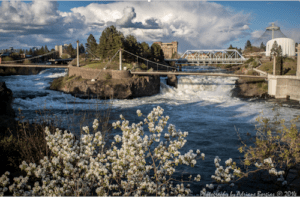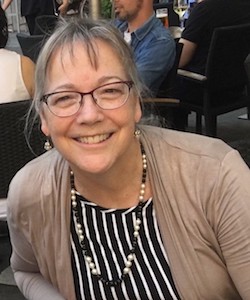By Adriane P. Borgias for EDRBlog.org
“No man ever steps in the same river twice, for it’s not the same river and he’s not the same man.” HERACLITUS
 By the end of 2011, the Spokane River community had learned its lesson. After more than eleven years of disputes, delays, and lawsuits, a plan for improving dissolved oxygen in the river was completed and now an even more ambitious goal lay ahead.
By the end of 2011, the Spokane River community had learned its lesson. After more than eleven years of disputes, delays, and lawsuits, a plan for improving dissolved oxygen in the river was completed and now an even more ambitious goal lay ahead.
Studies of fish tissue show the Spokane River doesn’t meet water quality standards for polychlorinated biphenyls (PCBs), a group of man-made chemicals that persist in the environment, accumulate in the food chain, and are known to have toxic effects. These standards are so stringent that it’s difficult to measure such a small amount of PCBs in water. It’s like looking for a pea in an area the size of the state of Washington to determine that the standard has been met.
Federal law requires Washington to develop a strategy for meeting clean water requirements. Although we, along with the community, are committed to a fishable, swimmable river, achieving an extremely low water quality standard is a daunting task.
Get notified when new articles are posted to the EDR blog – sign up for our email list »
PCBs remain in the environment and build up over time in fish, animals and people. That’s why finding even tiny amounts of these chemicals in the Spokane River requires action. But the technologies needed to remove PCBs from water and achieve the water quality standard are prohibitively expensive. This challenge is made all the more difficult by the reality that our communities are already strained by the increasing costs of wastewater treatment and the source of PCBs in the river isn’t just from the end of a wastewater pipe. This means that we must consider addressing all aspects of PCB reduction, including removing it from our products, preventing PCBs that are still in use from reaching the river, cleaning up old spills, as well as removing PCBs from wastewater prior to discharge.
Thankfully, the vision of a better path forward, paired with a dose of creativity and a belief in the ability of the community to lead the way, gave birth to the Spokane River Regional Toxic Task Force, a collaborative effort to simultaneously find and reduce sources of PCBs to the Spokane River.
The Task Force represents a broad group of interests including business, conservation groups, and state, local and Federal government agencies. In 2012, these interests carefully crafted a Memorandum of Agreement that provides the necessary structure to guide towards reaching common goals through consensus decision making. The organizational concepts outline its vision:
to characterize the sources of toxics in the Spokane River and identify and implement appropriate actions needed to make measurable progress towards meeting applicable water quality standards for the State of Washington, State of Idaho, and The Spokane Tribe of Indians and in the interests of public and environmental health.
One of the group’s first challenges – how to measure success.
As the state agency in charge of ensuring federal clean water requirements are being met, it is the Washington State Department of Ecology’s responsibility to hold the group accountable and make measurable progress. With the group’s input, Ecology developed its Measurable Progress definition, which is the process used to ensure our work is productive and achieves environmental results. In making the evaluation, Ecology documented the actions the Task Force has taken, work completed, and evidence that the environment is improving, such as the amount of PCBs removed or prevented from reaching the river.
At Ecology, we believe that the Task Force provides a huge benefit to our mission. As Grant Pfeifer, our Regional Director says, “Any good partnership includes listening and discovering mutual interests: not just one party discovering what is good for them, but wrestling with what is going to work best for all of us.” Task force participants have created a safe space to air opinions and discuss difficult issues. In the words of Tom Agnew, one of the Task Force members from the Liberty Lake Sewer and Water District, we have “created a community within our region of people who sit down together, who want to make it work, and understand the need to make it work. We might not see things the same way but we are talking about everything openly, candidly, and in a way that identifies the correct steps we need to take.”
The participating environmental groups also find a voice at the table. “We are sitting across the table from people with pipes in the river and our mission is to negotiate for cleaner water,” says Jerry White with the Spokane Riverkeeper, “Oftentimes there is tension inside that discussion but because we are all together, if I need information or an open dialog, then usually that is forthcoming.”
Six years ago this process faced naysayers on all sides; many people said the challenge before the Task Force—to find ways to reduce PCBs and create a comprehensive PCB reduction plan—was too great and the differences between the stakeholders too large. Yet, when the Task Force approved its Comprehensive Plan to Reduce PCBs in the Spokane River in November 2016, a major milestone was achieved and the seemingly impossible was accomplished.
At Ecology, we have found that innovative partnerships such as this are essential to our mission: sustain healthy land, air and water in harmony with a strong economy. The Task Force exemplifies how to create the capacity needed for engaging in productive dialogue. By using each organization’s unique purposes and strengths, we have found ways to protect the environment and also ensure long term sustainability for the community and its businesses.
In reflecting on the past and how others might learn from the Spokane River example, I share these observations:
- Successful collaborative efforts often grow from contentious issues and a belief in the community’s leadership potential.
- Environmental agencies are evolving from regulators to partners. Environmental problems are solved when the community becomes the problem solver.
- Mutual self-interest is a powerful tool. As shared resources become more cherished, these types of efforts help us wrestle with the impossible and find solutions that work for all of us.
Perhaps most importantly, in the end, sitting around the table talking is making the river cleaner.
BIOGRAPHY
 Adriane P. Borgias’ passion for the collaborative process revealed itself after she took a workshop on consensus-based decision making. She has experienced first-hand how collaboration can help communities work through difficult and contentious issues.
Adriane P. Borgias’ passion for the collaborative process revealed itself after she took a workshop on consensus-based decision making. She has experienced first-hand how collaboration can help communities work through difficult and contentious issues.
Adriane Borgias has a BS in Chemistry from the University of California, Berkeley, and an MS in Environmental Management from the University of San Francisco. She has been a Certified Hazardous Materials Manager since 1986.
Adriane joined the Washington State Department of Ecology in 2012 as Water Quality Lead for the Spokane River. Prior to that time she worked as an environmental professional in industry, for a tribal government and as an independent consultant. In 2010 Ms. Borgias spent 4 months in Bangalore, India as a Fulbright-Nehru Environmental Leadership Scholar.
